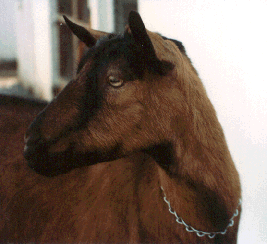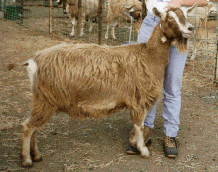
Dairy Goats
There are six types of dairy goats that are recognized by the American
Dairy Goat Association. They are Nubians, LaManchas, Alpines,
Oberhaslis, Togenburgs, and Saanens. More people drink Goat's Milk than cow's milk.

Nubians
have very long, floppy ears and they can be any color. They have a
convex nose and are one of the larger breeds of goats. Their milk
tends to be higher in protein and butter fat than other breeds. They
tend to be a little bit more stubborn than other dairy goats and make
a distinctive sound. Even Nubian kids sound like they are complaining.

LaManchas
have ears that are so small that it looks like they don't have
ears and they can also be any color. They have a straight nose and
are a small breed. The LaMancha sound is
typical of other goats. In our experience, they are more calm and
gentle than other breeds. When you own a LaMancha, be prepared
to answer the question What did you do to its ears?

Alpines can be almost any color except solid white and light
brown with white markings (toggenburg color); their face should be
dished or straight. They have erect ears and are a medium-large
breed. They are popular with dairies due the amount of milk they
produce.

Oberhaslis have very specific color standards. They are
a bay color, known as Chamoise, with a black dorsal strip,
udder, belly, and black below the knees. They should also have a
nearly black head. Another aceptable color would be all black but
this is only acceptable for does. They have erect ears and are a
medium-small breed.

Toggenburgs
also have very specific color requirements. They are light brown and
have white ears and lower legs. The side of the tail and two stripes
down the face must also be white. They have erect ears and have the
smallest height requirments of all the breeds, but most of the
toggenburgs I've seen are pretty big. They grow a shaggier coat than
other dairy goat breeds. They also are popular with dairies. In our
experience, they tend to be a little wilder and more high strung than
other breeds.

Saanens are usually pure white. They usually have a large
udder capacity and are popular with dairies due to the quantity of
milk they produce.
Parts of The Dairy Goat Doe

Goat Milk

Goat milk is used for human consumption. In fact, more people in
the world drink goat milk than cow milk, although in the US the
opposite is true. Goat milk is similar nutitionally to cow milk, but
it contains smaller fat globules and as a consequence it is easier for
some people to digest and it does not require homogenization.

Goat milk
is also used to feed many other animals. Usually, they are bottle
feed, but goats will fairly easily adopt lambs (with a bit of coaxing),
and we've even heard of a goat who would jump up on bale of hay to
allow a foal (baby horse) to nurse.
Back to  Page 2: Basic care
Page 2: Basic care
Forward to Page 4: Pygmy Goats 
Back to http://www.goats4h.com/Goats.html The Goat home page
Back to http://www.goats4h.com/InfoDirtRoad.html
The Information Dirt Road home page These pages were designed by Lynn of the Computer Science project of the Irvine
Mesa Charros 4-H Club.
More Farm Information









 Page 2: Basic care
Page 2: Basic care
